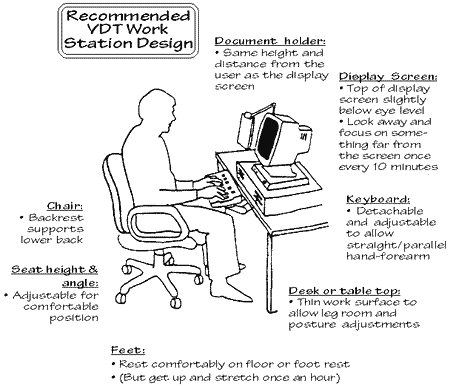NOTE: This UE Steward has not been updated since it was first published over a decade ago. Some information may no longer be accurate.

In 1990 OSHA began a process that was supposed to end with the issuing of rules on workplace ergonomics to deal with many various forms of Cumulative Trauma Disorders (CTD). The issuing of these new rules has been stalled in Congress for 8 years by pro-business republicans and democrats.
So what is "ergonomics" and "CTDs" and since OSHA hasnt issued these rules can we still file grievances over these type of health & safety problems?
Ergonomics is simply defined by OSHA as the study of work. The point of ergonomics is to adapt the job to fit the person, thereby eliminating injuries rather then make the person adapt to the job.
Example: A worker who has to sit at a desk and type in computer data all day has a non-adjustable chair. This worker gets severe shoulder strain and carpel tunnel syndrome because the chair is too low and she has to sit and type in an awkward position. The ergonomic solution is to have adjustable chairs, since workers come in different sizes, rather then a one size fits all chair.
Cumulative Trauma Disorders (CTDs) are a whole series of injuries that workers get when they do the same repetitive motion. They include carpel tunnel syndrome, tendinitis, De Quervains disease and trigger finger to name a few. Most of these syndromes were first recognized among factory workers who had to do the same repetitive task hundreds and thousands of times a day. It is now recognized that office workers who work steady at data entry on computers are suffering many of the same injuries. It is the repetitive nature of the task that does the injury, not just the physical nature of the work.
It is this recognition of injuries happening to white collar workers that has led to wider employer opposition to the OSHA rules on CTDs. Some insurance companies have data input "factories" where thousands of workers do nothing but enter the data into computers for eight or more hours a day. In settings like that, CTDs are rampant.
We can still grieve unsafe working conditions. If your contract contains a clause calling for a "safe and healthy workplace" then you can file a grievance and work to have the workplace made safe for the workers. Even if you dont have a health and safety clause a steward can still file a grievance under the recognition clause. Remember, although OSHA hasnt issued their specific rules on ergonomics, it is still illegal to make workers work in unsafe conditions.
MORE INFORMATION
Occupational Safety and Health Administration (OSHA) standards, posters, policies and materials can be obtained either free directly from OSHA or at cost from the U.S. Government printing office.
Go to www.OSHA.gov.
If workers in a given job assignment or classification are coming down with the same or similar injuries then the likelihood is that something is wrong with the job.
If you contact your local OSHA office they can provide material on safe ergonomics for both factories and offices.
